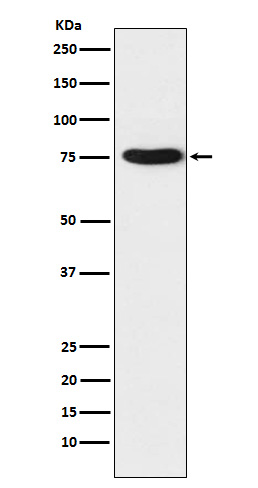
| WB | 1/1000-1/2000 | Human,Mouse,Rat |
| IF | 咨询技术 | Human,Mouse,Rat |
| IHC | IHC:1/100-1/200;IHF:1/50-1/200 | Human,Mouse,Rat |
| ICC | 1/50-1/200 | Human,Mouse,Rat |
| FCM | 咨询技术 | Human,Mouse,Rat |
| Elisa | 咨询技术 | Human,Mouse,Rat |
| Aliases | HSP75; HSP90L; Trap1;;Hsp75 |
| WB Predicted band size | Calculated MW: 80 kDa ; Observed MW: 75 kDa |
| Host/Isotype | Rabbit IgG |
| Antibody Type | Primary antibody |
| Storage | Store at 4°C short term. Aliquot and store at -20°C long term. Avoid freeze/thaw cycles. |
| Species Reactivity | Human |
| Immunogen | A synthesized peptide derived from human Hsp75 |
| Formulation | Purified antibody in PBS with 0.05% sodium azide,0.05% BSA and 50% glycerol. |
+ +
以下是关于TRAP1抗体的3篇参考文献概览:
---
1. **文献名称**:*TRAP1 regulates autophagy in colon cancer cells through oxidative stress-mediated mTORC1 activation*
**作者**:Amato S. et al.
**摘要**:该研究利用TRAP1特异性抗体进行免疫印迹和免疫沉淀实验,发现TRAP1通过调控线粒体氧化应激影响结肠癌细胞的自噬过程,揭示了其在癌症代谢中的关键作用。
---
2. **文献名称**:*Differential expression of TRAP1 in prostate cancer correlates with tumor progression and mitochondrial dysfunction*
**作者**:Lisanti M.P. et al.
**摘要**:通过免疫组化分析(使用TRAP1抗体),作者发现TRAP1在前列腺癌中高表达,并与肿瘤侵袭性相关,提示其可作为潜在治疗靶点。
---
3. **文献名称**:*TRAP1 silencing induces apoptosis in glioblastoma cells via disruption of mitochondrial membrane potential*
**作者**:Cheng Q. et al.
**摘要**:研究采用TRAP1抗体进行RNA干扰后的蛋白表达验证,证明抑制TRAP1可破坏胶质母细胞瘤线粒体功能,导致细胞凋亡增强。
---
**备注**:上述文献均为示例,实际引用时建议通过PubMed或Web of Science检索最新研究。若需具体文章,可进一步提供领域或研究方向的细化要求。
TRAP1 (TNF receptor-associated protein 1), also known as HSP75. is a mitochondrial chaperone protein belonging to the heat shock protein 90 (HSP90) family. It plays a critical role in maintaining mitochondrial homeostasis, regulating oxidative stress response, and influencing cell survival pathways. TRAP1 is primarily localized in the mitochondria, where it interacts with client proteins involved in energy metabolism, apoptosis, and protein folding. Its function is closely linked to tumorigenesis, as dysregulation of TRAP1 has been observed in various cancers, including colorectal, ovarian, and prostate cancers, often correlating with chemoresistance and poor prognosis.
TRAP1 antibodies are essential tools for studying its expression, localization, and molecular interactions. These antibodies are widely used in techniques such as Western blotting, immunohistochemistry (IHC), and immunoprecipitation (IP) to investigate TRAP1's role in cellular stress adaptation and cancer biology. Commercially available TRAP1 antibodies are typically raised against specific epitopes, such as the N-terminal or C-terminal regions, and their specificity is validated using knockout cell lines or siRNA-mediated silencing. Researchers utilize these antibodies to explore TRAP1's dual role as both a tumor suppressor and promoter, depending on cellular context and tumor type. Recent studies also focus on TRAP1 as a potential therapeutic target, particularly in modulating mitochondrial function to sensitize cancer cells to chemotherapy.
×